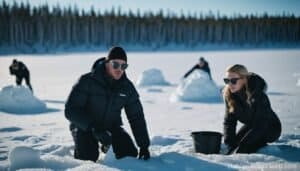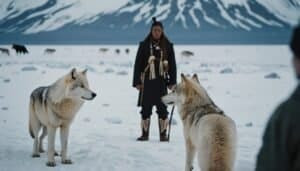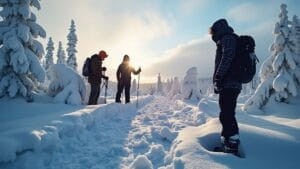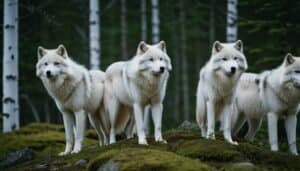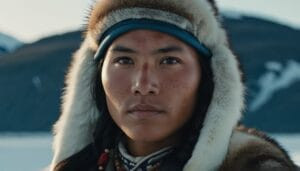Introduction
The role of media in Arctic wolf conservation awareness is crucial. This article delves into the key media channels promoting Arctic wolf conservation, their effectiveness in influencing public perception, and highlights successful media campaigns and contributions
We will explore the impact of social media, documentaries, news outlets, and the challenges faced in promoting conservation efforts
Key Media Channels Promoting Arctic Wolf Conservation
Media plays a vital role in promoting Arctic wolf conservation by spreading awareness and educating the public about the challenges these animals face. The key channels include social media platforms, documentaries and films, and news outlets
Social Media Platforms
Social media platforms have revolutionized how information about conservation is disseminated
Platforms like Facebook, Instagram, Twitter, and TikTok allow organizations and individuals to share real-time updates, images, and videos of Arctic wolves. This immediacy helps generate empathy and a sense of urgency among the public:
Awareness Campaigns: Nonprofits and conservation groups often use social media to run targeted awareness campaigns
For example, the World Wildlife Fund (WWF) frequently posts about Arctic wolves, educating followers on the impact of climate change on their habitat. These campaigns can reach millions of users, amplifying the message far beyond traditional methods
Viral Content: User-generated content can also play a significant role
Viral videos or images of Arctic wolves can capture the public’s attention, leading to increased awareness and support for conservation efforts. Hashtags like #SaveTheArcticWolf can trend, creating widespread visibility
Engagement and Advocacy: Social media enables direct interaction between conservationists and the public
This engagement can lead to increased donations, volunteer sign-ups, and active participation in advocacy efforts. For instance, online petitions and fundraising campaigns for Arctic wolf conservation often gain traction through social media platforms
Documentaries and Films
Documentaries and films are powerful tools for raising awareness about the plight of Arctic wolves. They provide an in-depth look at the lives of these animals, their ecosystems, and the threats they face:
In-Depth Storytelling: Documentaries like “The Arctic Wolf: Living with the Pack” offer viewers a glimpse into the daily lives of Arctic wolves, highlighting their behavior, social structures, and the harsh conditions they endure. This storytelling approach helps viewers form an emotional connection with the animals
Educational Value: Films often include expert interviews and scientific insights, educating viewers about the broader ecological context. They explain how Arctic wolves are indicators of environmental health and the impacts of climate change on the Arctic ecosystem
Broad Reach: Documentaries and films can reach a wide audience through various distribution channels, including streaming services, television broadcasts, and educational institutions. This broad reach ensures that the message about Arctic wolf conservation reaches diverse and global audiences
News Outlets
Traditional news outlets remain a crucial source of information about Arctic wolf conservation. News stories can bring immediate attention to urgent issues and ongoing conservation efforts:
Breaking News: News outlets are often the first to report on significant events impacting Arctic wolves, such as habitat destruction, climate change effects, or new conservation initiatives. This immediacy can mobilize public and governmental responses quickly
Investigative Journalism: In-depth investigative reports can uncover hidden threats to Arctic wolves, such as illegal hunting or insufficient protective regulations. These reports can lead to policy changes and increased protection measures
Regular Coverage: Regular news coverage keeps the topic of Arctic wolf conservation in the public eye. Articles, interviews, and opinion pieces in major newspapers and online news platforms can sustain public interest and support for ongoing conservation efforts
The collaboration of social media platforms, documentaries and films, and news outlets significantly enhances the visibility and effectiveness of Arctic wolf conservation initiatives. Each channel plays a unique role in educating the public, generating support, and driving action to protect these magnificent animals
Effectiveness of Media and Public Perception
Media’s effectiveness in influencing public perception and driving conservation efforts is significant. By leveraging various platforms, media can shape how the public views Arctic wolves and their conservation needs
This section explores the influence of social media, the role of documentaries, and the impact of news outlets on Arctic wolf conservation
Social Media’s Influence
Social media’s reach and engagement capabilities make it a powerful tool for conservation awareness. It can rapidly disseminate information and create a community of engaged supporters:
Real-Time Updates: Social media allows for the immediate sharing of news and updates about Arctic wolves
Conservation organizations can post about recent sightings, new research findings, or urgent threats to their habitats. This real-time information keeps the public informed and engaged
Community Building: Social media fosters a sense of community among conservation supporters
Groups and pages dedicated to Arctic wolf conservation allow members to share information, discuss issues, and organize events. This community engagement is crucial for sustaining long-term interest and action
Influencer Partnerships: Collaborating with social media influencers can amplify conservation messages
Influencers with large followings can reach a broad audience, raising awareness and encouraging their followers to support conservation initiatives
Role of Documentaries
Documentaries provide a deep, immersive experience that can profoundly impact viewers’ understanding and attitudes towards Arctic wolves and their conservation:
Emotional Engagement: Documentaries often tell compelling stories that emotionally engage viewers. By showcasing the beauty and complexity of Arctic wolves’ lives, these films foster empathy and a desire to protect these animals
Educational Content: Documentaries are educational tools that provide viewers with a wealth of information about Arctic wolves. They explain the scientific and ecological importance of these animals, making a strong case for their conservation
Broad Distribution: With the rise of streaming platforms like Netflix, Amazon Prime, and Disney+, documentaries can reach a global audience. This widespread distribution increases the impact of conservation messages and attracts international support
News Outlets Impact
News outlets play a critical role in informing the public about conservation issues and driving policy changes:
Credibility and Authority: News outlets are often seen as credible sources of information. When they cover Arctic wolf conservation, it lends authority to the issue and can influence public opinion and policy decisions
Investigative Reporting: In-depth investigative reports by journalists can uncover hidden threats to Arctic wolves and expose gaps in conservation efforts. These reports can lead to increased scrutiny and pressure on authorities to implement protective measures
Sustained Coverage: Regular news coverage ensures that Arctic wolf conservation remains a topic of public interest. Continuous reporting keeps the issue in the spotlight, maintaining momentum for conservation initiatives
Changing Public Perception
Media coverage significantly influences how the public perceives Arctic wolves and their conservation needs:
Raising Awareness: By highlighting the challenges Arctic wolves face, media coverage raises public awareness about the importance of conservation. Stories about habitat loss, climate change, and human-wildlife conflict make the public more informed and concerned
Combating Misconceptions: Media can address and correct misconceptions about Arctic wolves. By providing accurate information and expert opinions, media coverage can change negative perceptions and promote a more positive view of these animals
Encouraging Action: When the public is informed and emotionally engaged, they are more likely to take action. Media coverage can inspire people to donate to conservation organizations, participate in advocacy campaigns, and adopt sustainable practices that benefit Arctic wolves
Celebrity Endorsements
Celebrity endorsements can greatly enhance media campaigns for Arctic wolf conservation:
Influence and Reach: Celebrities have a significant influence on public opinion. When they endorse conservation efforts, they bring attention to the cause and encourage their fans to support it
Awareness Campaigns: Celebrities can participate in awareness campaigns, using their platforms to spread the message about Arctic wolf conservation. Their involvement can lead to increased media coverage and public interest
Fundraising Efforts: Celebrities can also help raise funds for conservation initiatives. By hosting events, participating in charity drives, and using their influence to solicit donations, they can generate substantial financial support for Arctic wolf conservation
Challenges in Media Promotion
Despite its effectiveness, media promotion of Arctic wolf conservation faces several challenges:
Misinformation: The spread of misinformation on social media can undermine conservation efforts. False or misleading information about Arctic wolves can create confusion and hinder effective advocacy
Media Fatigue: Continuous exposure to conservation messages can lead to media fatigue, where the public becomes desensitized and less responsive to appeals for support. It is crucial to keep content fresh and engaging to maintain interest
Resource Constraints: Creating high-quality media content requires significant resources. Conservation organizations often face budget constraints that limit their ability to produce and distribute impactful media
The effectiveness of media in influencing public perception and driving conservation efforts is undeniable. Social media, documentaries, and news outlets each play a crucial role in raising awareness, educating the public, and inspiring action to protect Arctic wolves
Overcoming challenges in media promotion is essential to sustaining these efforts and ensuring the long-term survival of Arctic wolves
Successful Media Campaigns and Contributions
Successful media campaigns have a significant impact on Arctic wolf conservation by raising awareness, generating support, and driving tangible conservation actions
This section explores notable case studies, educational campaigns, and the contributions of print media to Arctic wolf conservation
Case Studies
Examining successful media campaigns provides insights into strategies that effectively promote Arctic wolf conservation:
WWF’s #SaveOurWolves Campaign: The World Wildlife Fund (WWF) launched the #SaveOurWolves campaign, utilizing various media platforms to highlight the threats faced by Arctic wolves
The campaign included social media posts, videos, and interactive content, which engaged millions of people worldwide. The use of powerful imagery and compelling storytelling helped convey the urgency of conservation efforts and encouraged public participation and donations
NatGeo’s Arctic Wolf Features: National Geographic has produced several articles and documentaries focusing on Arctic wolves
Their high-quality visuals and in-depth reporting have brought the plight of these animals to a global audience. The combination of scientific information and emotional storytelling in these features has effectively raised awareness and inspired action
Greenpeace’s Arctic Campaigns: Greenpeace has conducted numerous campaigns to protect the Arctic and its wildlife, including Arctic wolves
By using dramatic footage and personal narratives, Greenpeace has successfully garnered media attention and public support. Their campaigns often include calls to action, such as signing petitions and participating in protests, which have led to policy changes and increased protections for the Arctic environment
Educational Campaigns
Educational campaigns play a crucial role in informing the public about Arctic wolves and the importance of conservation:
Wildlife Education Programs: Organizations like Defenders of Wildlife run educational programs that include presentations, workshops, and online resources about Arctic wolves
These programs are designed to educate school children, communities, and the general public about the ecological significance of Arctic wolves and the threats they face. Interactive activities and multimedia content help make the information accessible and engaging
Public Service Announcements (PSAs): PSAs on television, radio, and online platforms have been effective in spreading conservation messages
Short, impactful PSAs can quickly convey important information and motivate viewers to learn more and take action. For example, a PSA highlighting the impact of climate change on Arctic wolf habitats can prompt viewers to support environmental policies and conservation organizations
Partnerships with Educational Institutions: Collaborations between conservation organizations and educational institutions have resulted in comprehensive educational campaigns
These partnerships often involve creating curriculum materials, hosting guest lectures, and organizing field trips that focus on Arctic wolf conservation. By integrating conservation topics into formal education, these campaigns ensure that future generations are informed and motivated to protect wildlife
Print Media Contributions
Despite the digital shift, print media continues to play a vital role in Arctic wolf conservation awareness:
Magazine Articles: Print magazines such as National Geographic, Wildlife Conservation, and Ranger Rick frequently publish articles on Arctic wolves
These articles often feature stunning photography and in-depth analysis, capturing readers’ interest and providing detailed information about conservation efforts
Books and Publications: Books and academic publications on Arctic wolves contribute to the body of knowledge available to both the public and the scientific community
Notable works, such as “The Arctic Wolf: Ten Years with the Pack” by L. David Mech, provide comprehensive insights into the lives and conservation of Arctic wolves. These publications serve as valuable resources for education and advocacy
Newspaper Coverage: Newspapers play an essential role in local and national awareness
Investigative pieces, opinion columns, and news reports on Arctic wolves help keep the topic in the public discourse. For instance, a feature story on the front page of a major newspaper can reach a broad audience and prompt readers to support conservation initiatives
Successful media campaigns and contributions from various media forms have significantly advanced Arctic wolf conservation efforts
Case studies of impactful campaigns, educational initiatives, and the enduring role of print media illustrate the diverse strategies employed to raise awareness, educate the public, and drive conservation actions. By learning from these successes and continuing to innovate, conservation organizations can sustain and amplify their efforts to protect Arctic wolves
Conclusion
Media plays an indispensable role in Arctic wolf conservation awareness. By leveraging social media platforms, documentaries, news outlets, and print media, conservation organizations can effectively disseminate information, educate the public, and drive actionable support for Arctic wolf protection
Social media’s real-time updates, community-building capabilities, and influencer partnerships create a dynamic environment for spreading awareness. Documentaries and films offer emotional engagement and educational content, reaching global audiences through broad distribution channels. News outlets provide credible, authoritative coverage, from breaking news to in-depth investigative reports, sustaining public interest and influencing policy changes
Successful media campaigns, such as WWF’s #SaveOurWolves and NatGeo’s Arctic wolf features, demonstrate the power of strategic storytelling and visual appeal. Educational campaigns and partnerships with educational institutions further enhance public understanding and engagement
Despite the rise of digital media, print media remains a vital tool, with magazines, books, and newspapers continuing to contribute significantly to the conservation narrative
The collaboration of these media channels not only raises awareness but also shifts public perception, combats misconceptions, and encourages tangible conservation actions. Overcoming challenges like misinformation and media fatigue is crucial for maintaining momentum
By learning from successful campaigns and continuously innovating, the media can ensure sustained and amplified efforts to protect Arctic wolves, securing their future in the face of growing environmental threats


